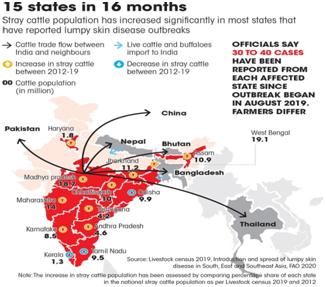A disease, Lumpy Skin Disease (LSD) is spreading among cattle across several villages in the Kammana in Kerala’s Wayanad district.
What is lumpy skin disease?

|
Spread in India
|
The infectious nature of LSD and its implications cause significant economic losses to farmers. Major reasons for the loss are as given below:
The disease will have a devastating impact on the country, where most dairy farmers are either landless or marginal landholders and milk is among the cheapest protein source. The disease needs to be checked and controlled immediately. Otherwise, it will spread rapidly and have a lasting impact on economy.
Verifying, please be patient.